CRP deposition in human abdominal aortic aneurysm is associated with transcriptome alterations toward aneurysmal pathogenesis: insights from in situ spatial whole transcriptomic analysis
- PMID: 39737187
- PMCID: PMC11682986
- DOI: 10.3389/fimmu.2024.1475051
CRP deposition in human abdominal aortic aneurysm is associated with transcriptome alterations toward aneurysmal pathogenesis: insights from in situ spatial whole transcriptomic analysis
Abstract
Background: We investigated the effects of C-reactive protein (CRP) deposition on the vessel walls in abdominal aortic aneurysm (AAA) by analyzing spatially resolved changes in gene expression. Our aim was to elucidate the pathways that contribute to disease progression.
Methods: AAA specimens from surgically resected formalin-fixed paraffin-embedded tissues were categorized into the AAA-high CRP [serum CRP ≥ 0.1 mg/dL, diffuse and strong immunohistochemistry (IHC); n = 7 (12 cores)] and AAA-low-CRP [serum CRP < 0.1 mg/dL, weak IHC; n = 3 (5 cores)] groups. Normal aorta specimens obtained during heart transplantation were used as the control group [n = 3 (6 cores)]. Spatially resolved whole transcriptomic analysis was performed, focusing on CD68-positive macrophages, CD45-positive lymphocytes, and αSMA-positive vascular smooth muscle cells.
Results: Spatial whole transcriptomic analysis revealed significant differential expression of 1,086, 1,629, and 1,281 genes between high-CRP and low-CRP groups within CD68-, CD45-, and αSMA-positive cells, respectively. Gene ontology (GO) analysis of CD68-positive macrophages identified clusters related to inflammation, apoptosis, and immune response, with signal transducer and activator of transcription 3 implicated across three processes. Notably, genes involved in blood vessel diameter maintenance were significantly downregulated in the high-CRP group. GO analysis of lymphocytes showed upregulation of leukocyte rolling and the apoptosis pathway, whereas, in smooth muscle cells, genes associated with Nuclear factor kappa B (NF-κB) signaling and c-Jun N-terminal Kinase (JNK) pathway were upregulated, and those related to blood pressure regulation were downregulated in the high-CRP group.
Discussion: CRP deposition was associated with significant transcriptomic changes in macrophages, lymphocytes, and vascular smooth muscle cells in AAA, suggesting its potential role in promoting pro-inflammatory and apoptotic processes, as well as contributing to the degradation of vascular structure and elasticity.
Keywords: C-reactive protein; STAT3; abdominal aortic aneurysm; apoptosis; inflammation; spatial transcriptomics.
Copyright © 2024 Kim, Seok, Lim, Koh, Bae, Kim, Ryu, Ok, Choi, Cho and Oh.
Conflict of interest statement
The authors declare that the research was conducted in the absence of any commercial or financial relationships that could be construed as a potential conflict of interest.
Figures
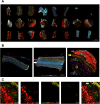

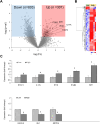
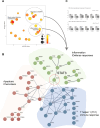
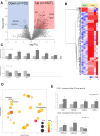
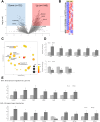
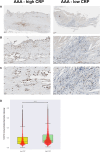

Similar articles
-
Single-cell RNA sequencing reveals the cellular heterogeneity of aneurysmal infrarenal abdominal aorta.Cardiovasc Res. 2021 Apr 23;117(5):1402-1416. doi: 10.1093/cvr/cvaa214. Cardiovasc Res. 2021. PMID: 32678909 Free PMC article.
-
Integrative analysis of single-Cell RNA sequencing and experimental validation in the study of abdominal aortic aneurysm progression.Gene. 2024 Dec 15;929:148820. doi: 10.1016/j.gene.2024.148820. Epub 2024 Aug 3. Gene. 2024. PMID: 39103059
-
BAF60a Deficiency in Vascular Smooth Muscle Cells Prevents Abdominal Aortic Aneurysm by Reducing Inflammation and Extracellular Matrix Degradation.Arterioscler Thromb Vasc Biol. 2020 Oct;40(10):2494-2507. doi: 10.1161/ATVBAHA.120.314955. Epub 2020 Aug 13. Arterioscler Thromb Vasc Biol. 2020. PMID: 32787523 Free PMC article.
-
The putative role of autophagy in the pathogenesis of abdominal aortic aneurysms.Atherosclerosis. 2017 Feb;257:288-296. doi: 10.1016/j.atherosclerosis.2017.01.017. Epub 2017 Jan 16. Atherosclerosis. 2017. PMID: 28139205 Review.
-
Micro-RNAs in abdominal aortic aneurysms: insights from animal models and relevance to human disease.Cardiovasc Res. 2016 May 15;110(2):165-77. doi: 10.1093/cvr/cvw046. Epub 2016 Mar 10. Cardiovasc Res. 2016. PMID: 26965051 Review.
References
MeSH terms
Substances
LinkOut - more resources
Full Text Sources
Research Materials
Miscellaneous

